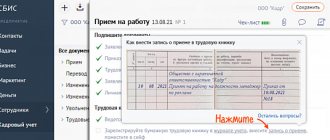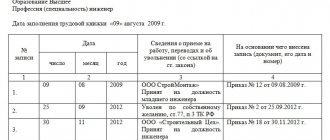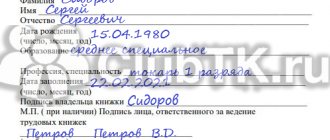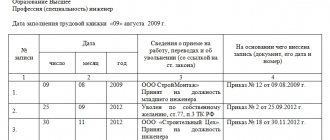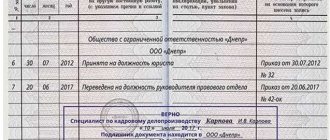Until December 31, 2022, workers had the opportunity to submit an application to the employer to switch to electronic labor. For those who decided not to digitalize information about their work activities, the book was left in paper form. It is worth noting that such workers are still the majority. According to the Russian Pension Fund, only 6 million people chose an electronic book instead of the regular format.
Thus, employers still have the obligation to properly maintain and store paper work records.
- Which document established new labor rules?
- New form of work book
- Responsible for maintaining work records
- Accounting for work records
- Registration of labor: how to make notes
- Making an insert in the work book
Which document established new labor rules?
On September 1, 2022, Order of the Ministry of Labor of the Russian Federation dated May 19, 2021 No. 320n (hereinafter referred to as the Order of the Ministry of Labor) came into force. He approves the form, procedure for maintaining and storing work books. The document is valid until September 1, 2027.
Basically, the Order contains the provisions of the Decree of the Government of the Russian Federation of April 16, 2003 No. 225, which has become invalid. At the same time, important changes appeared in the new document.
Also, Resolution of the Ministry of Labor of Russia dated October 10, 2003 No. 69, which contained instructions for filling out work books, has also lost force.
When to use the new work book form
Decree of the Government of the Russian Federation dated July 24, 2021 No. 1250 establishes several rules:
- The new sample work books will come into force on January 1, 2023. But such a need can arise only in two cases - if the book was lost or damaged. Those employees who are employed for the first time need to immediately create electronic work records.
- Existing old-style work books remain valid and cannot be exchanged for new ones.
- Existing forms of work books and old-style forms of inserts in them can be used without a time limit.
How the paper work book has changed since September 1, 2021
Responsible for maintaining work records
The organization of work on maintaining work books begins with the appointment of someone responsible for this work. Clause 45 of the Order of the Ministry of Labor specifies that an authorized person is appointed by order of the employer.
The order can be prepared in any form. At the same time, it is important to indicate in it who will maintain work books in the absence of an authorized person. Some employers resort to the wording that if such a situation arises, an additional responsible person will be appointed by a separate order. But one order is not enough. Otherwise, such an action will conflict with Art. 4 of the Labor Code of the Russian Federation, prohibiting forced labor.
HR specialists are required to maintain work records in their job description. But often this work is entrusted to the chief accountant, office manager - those whose labor functions are not related to maintaining work books. To do this legally, in addition to the order, you must draw up an additional agreement to the employment contract or additionally make changes to the job description.
Work books by series and years
Despite the ongoing talk about the abolition of work books, such a decision has not been finally made by the Government, so people involved in personnel records should have an idea of what the document looks like correctly .
First of all, this is necessary to exclude counterfeit or invalid forms .
Compliance with the year of issue and the series of the work book, according to the Labor Code of the Russian Federation.
Sample 1973 (AT - TK series)
Sample 2003
Accounting for work records
The employer is responsible for keeping track of work books, as well as work book forms and inserts in it.
For this purpose, he must independently develop a book (journal) for recording the forms of the work book and the inserts in it, and in addition - a book for recording the movement of work books and inserts in them. The most important thing is to entrust the work to those who should do it.
For example, an employer often makes the mistake of delegating bookkeeping to the human resources department rather than the accounting department. But the HR department or the person responsible for maintaining labor records should be responsible for recording all the work books and the inserts in them in the book of accounting for the movement of work books.
Clause 40 of the Order of the Ministry of Labor specifies that both books must be numbered, laced, certified by the manager’s signature and seal. At the same time, from September 1, 2022, the requirements for wax sealing and sealing are canceled.
Example of filling out a work book: information about the employee
Starting from 2022, employers will no longer issue paper work books for employees starting work for the first time. They contain electronic information about work activities. Previously, the “starting” information about the employee was entered into the work book by his first employer. What kind of information is this? This is the surname, first name, patronymic, date of birth, education of the employee at the time of establishment of the work record book. All this information had to be entered in the appropriate columns of the title page.
After all the specified information about the employee was entered into the work book, the company put the date of completion on the title page and personally demonstrated to the employee the information that was entered in the book. Next, the employee, if all the information entered was correct, had to put his signature on the title page, after which a representative of the personnel department would sign on the same sheet. At this point, information about the employee was considered entered.
From 2022, employers need to enter this information only when issuing an employee a duplicate work book or an insert into it. New employment documents are no longer issued.
Once completed, the work book remains in the HR department of the employing company. And if necessary, he must update it (for example, change his last name). To do this, you should cross out the old data and enter new ones (if the changes concern the name, surname or patronymic of the specialist). If the changes concern education/profession, then you should simply add the current information to the work book as an additional entry immediately after the previous data (clauses 7-8 of the Rules).
For a sample of making an entry in the work book starting from September 1, 2022 about a change in the employee’s surname and for a sample change (addition) in the work book of an entry about new education, profession, specialty, see ConsultantPlus. Trial access to the system can be obtained for free.
Registration of labor: how to make notes
The rules for maintaining work books are prescribed in Appendix 2 to the Order of the Ministry of Labor. In particular, it is clarified that dates should be indicated in Arabic numerals.
In addition, there are certain standards for the use of pen and ink for making notes:
- It is allowed to use light-resistant ink (paste, paint, gel);
- ink color - black, blue or purple.
Please note that any abbreviations in entries are not allowed.
Recording in labor by transferring dyes
The new procedure for maintaining work books provides for the possibility of making entries by transferring dyes.
The Letter of the Ministry of Labor of the Russian Federation dated June 29, 2021 No. 14-6/ОOG-5976 clarifies what is meant by this method of making entries. This means that they can be produced using technical means, such as a printer.
Recording in labor records using printing
Is it possible to use a stamp of the organization's name to simplify the procedure for making entries in the work book?
Until September 1, 2022, this method of making entries did not meet the established requirements. Although the State Tax Inspectorate, as a rule, did not hold employers accountable for this.
From September 1, 2022, changes were made to the rules for filling out work books. Now records can be made in whole or in part using technical means by transferring dyes or in the form of a seal impression.
How to fill out a labor title page
Full name and date of birth are filled in on the basis of an identity document. The patronymic name is indicated if available.
Information about education is entered on the basis of an education document. If the document indicates a master’s or bachelor’s degree, then you can write “Higher – Bachelor’s Degree” or “Higher – Master’s Degree”.
In the line “profession, specialty” you need to indicate your profession, specialty, qualification. If the education document only indicates the direction, then the deadline may not be filled out.
Most questions arise about the signature of the person responsible for maintaining work records. The habit of indicating your full name has become firmly established in practice. Rostrud experts believe that this is exactly what should be done: on the title page, enter the name of the person responsible for maintaining it.
However, if you rely on GOST R 7.0.97-2016, then the signature should include:
- job title of the person signing the document;
- his handwritten signature;
- decryption of the signature (initials, surname).
But it is obvious that the format of the work book will not allow you to fit all this information in one line.
Please note that in the new work form, instructions appear on the title page that a seal is required if available.
Information about work in the work book
Entering information about employment has its own characteristics. Filling out this part of the labor report begins with column 3, where the name of the organization is indicated in accordance with the constituent documents, and the abbreviated name (if any) is also entered.
In the line below, in column 1, indicate the serial number of the entry being made. In column 2, enter the date of employment - in accordance with the order of employment.
Opposite the date of hiring, in column 3, the following entry is made according to the template: “Hired to <structural unit> <name of position, profession, specialty indicating qualifications>.” For example, “Hired to the HR department as a personnel officer.”
The structural unit is indicated if it is included in the employment contract.
Column 4 contains information about the order (date and number) on the basis of which the employee was hired. When making an entry, it is better to adhere to the following sequence: type of document, date, number. For example, “Order No. 28-k dated December 16, 2008.”
Fill out and submit to the Pension Fund the SZV-TD form using Kontur.Externa
At the stage of filling out information about employment, no records need to be certified with seals.
What to do if an employee changes his last name?
Entries in labor records about last name, first name, patronymic and date of birth can only be changed on the basis of the relevant documents and with reference to their number, date and the authority that issued the document.
The new rules detail exactly how this should be done:
- changes are made to the title page;
- the previous surname or first name, patronymic (if any), date of birth are crossed out with one line and new data is recorded;
- references to documents are made on the inside cover of the work book and certified by the signature of the employer or authorized person, as well as the seal of the organization (or the seal of the personnel service) (if there is a seal).
How to make changes about education and profession
The method for making changes and additions regarding education differs from the amendments that an employer makes when an employee’s last name changes.
In this case, the change is also made on the title page of the work document. There is no need to cross out anything. The rules only allow you to supplement existing entries or fill in lines without crossing out previously made entries.
Filling out information about a remote employee
The new rules contain clarifications on how to make entries for remote workers. Information about their work activities is entered:
- at their request;
- provided that for this they have provided a work permit (it can be sent by registered mail with notification).
Information about transfers
Previous rules provided for making entries in the work book only about permanent transfers. No temporary transfers were included in it.
The rules in force from September 1 stipulate how to make entries if a temporary transfer is recognized as permanent.
You should be guided by the following algorithm:
In column 1 of the “Work Information” section, indicate the serial number of the entry.
In column 2, we enter the date of transfer, that is, the actual start of the employee’s duties.
In column 3, we record the name of the structural unit indicating the position (job), specialty, profession (“Transferred <where and by whom>”). For example, “Transferred to the legal department as a lawyer.”
In column 4 - indicate the transfer order (type of document, date, number).
Record of military service time
According to clause 14 of the Order of the Ministry of Labor, records of military service and other types of civil service are made at the place of service.
Record of dismissal
The information about hiring also includes information about dismissal. How to do this correctly is formulated in paragraph 15 of the Order of the Ministry of Labor.
- Column 1 contains the serial number of the entry;
- Column 2 indicates the date of dismissal (termination of the employment contract);
- in column 3 a record is made of the reason for dismissal;
- Column 4 names the document on the basis of which the entry was made - an order (instruction) or other decision of the employer, its date and number.
Is the employee fired or the employment contract terminated?
Art. 84.1 of the Labor Code of the Russian Federation, which regulates the procedure for formalizing the termination of an employment contract. The rule that directly concerns the record of the basis and reason for termination of the employment contract sounds like this:
An entry in the work book about the basis and reason for termination of the employment contract must be made in strict accordance with the wording of this Code or other federal law and with reference to the relevant article, part of the article, paragraph of the article of this Code or other federal law.
At the same time, clause 17 of the Order of the Ministry of Labor obliges to make an entry in the work book about the grounds for termination of the employment contract with reference to the corresponding paragraph of the article of the Labor Code of the Russian Federation. Examples: “Dismissed by agreement of the parties, paragraph 1 of Article 77 of the Labor Code of the Russian Federation” or “Dismissed at his own request, paragraph 3 of Article 77 of the Labor Code of the Russian Federation.”
A contradiction arises, and it is not clear how to act in practice. It is necessary to be guided by the norms of a higher act. In this case, it is the Labor Code. The use of the norms of the Order of the Ministry of Labor will be regarded as a violation of federal law.
According to Evgenia Konyukhova, a leading expert consultant on labor legislation and personnel records management, if we assume that the Labor Code is higher in legal force than the Order of the Ministry of Labor, then it is more correct to use the wording “the employment contract is terminated”, “the employment contract is terminated”.
It is important to understand the difference between these two terms - “terminated” and “discontinued”.
“Termination” presupposes the lack of initiative of both the employee and the employer (that is, the circumstances have developed - for example, the term of the employment contract has expired). The term “termination” is used when there is an initiative of one of the parties. In Art. 78 of the Labor Code of the Russian Federation specifies the procedure for terminating an employment contract.
When registering the dismissal of an employee on the initiative of the employee, reference should be made to Art. 77 of the Labor Code of the Russian Federation, which uses the term “termination of an employment contract”. In paragraph 17 of the Order of the Ministry of Labor there is an explanation on this matter:
Upon termination of the employment contract on the grounds provided for in Part 1 of Art. 77 of the Labor Code of the Russian Federation (except for cases of termination of an employment contract at the initiative of the employer and due to circumstances beyond the will of the parties (clauses 4 and 10 of part 1 of this article), an entry about dismissal (termination of the employment contract) is made in the work book with reference to the corresponding paragraph of the first part of this article.
When dismissing an employee, all entries made in the work book during work for a particular employer must be certified by the signature of the employer or the person responsible for maintaining work books, and a seal (clause 36 of the Order of the Ministry of Labor). The employee’s signature on the notice of dismissal is not required from September 1, 2022.
How to fill out a work book regarding job information
“Starting” information, as stated above, is entered into the work book once, and then only updated if necessary.
However, the main content of the document in question is not information about the employee’s education and personality; This is information about the places where he worked at different periods of his life.
To record this type of information, the work book provides a section “Information about work”. Let's look at how to fill out this section in the work book.
The specialist’s first employer began filling out information about work and in the future they must be filled out every time he moves to a new organization, as well as every time there is a change in the employee’s official (career) position (unless the employee switches to electronic work).
This section reflects both general information about the place where the employee works, and specific information about his position and functions performed. In addition, if there is a transfer of an employee from one structural unit of the company to another or dismissal from the company, then this fact is also reflected in this section.
The section itself consists of 4 columns.
The first of them should indicate the sequence number of the event. The second column is intended to indicate the date when such an event took place. The content of the fact of the employee’s work biography is reflected in the third column. There, the employing company indicates (in the case of hiring a new specialist) the full and abbreviated name, as well as what position and department he was enrolled in.
The fourth column serves to document the authenticity of the event being reflected. Here the company indicates on the basis of which document, for example, an order from the manager, the specialist was enrolled in the organization’s staff. In this case, the main details of such a document should be specified in this column (clause 10 of the Rules).
The above algorithm should record all facts of an employee changing his main place of work, as well as his career advancement.
In addition, information about the specialist’s part-time work with another employer may also be reflected here. How to fill out a work book when working part-time is indicated in clause 11 of the Rules. According to them, it is the main employer who must enter information about part-time work with another employer into the work book. To do this, the employee must provide documentary evidence of the fact of part-time employment.
Entries about the hiring of a part-time worker, transfer and dismissal can be entered into the labor record and not in chronological order. For example, if an employee asked to enter data on part-time work from an employer from whom he had already left, the current employer can make two entries in a row: about hiring and dismissal, regardless of when it was. You can also include the start of part-time work in the employment record if the employee began working part-time before an employment contract was concluded with him at his main place of work with this employer.
Along with what is indicated in the work book, there is another section for reflecting information about the specialist’s work - “Information about awards”, which also consists of 4 columns and the procedure for filling which is essentially similar to the algorithm for making entries in the “Information about work” section. In this section, the company indicates the facts of awarding state awards, titles, certificates, etc. to the employee.
If an employee leaves the company, then this fact is also recorded in the work book in the “Work Information” section. In this case, it must be indicated (in column 3) on the basis of which (the reason and the corresponding norm) the employment contract was terminated. For example: “The employment contract was terminated by agreement of the parties, clause 1 of part 1 of article 77 of the Labor Code of the Russian Federation.”
IMPORTANT! The record of the specialist’s dismissal must be dated his last working day (clause 16 of the Rules).
At the same time, the employer should remember that if the reason for dismissal was the grounds in connection with which the employee has any benefits, then such grounds should also be listed in column 3 when making a record of the specialist’s departure from the company (for example, quitting due to leaving for a child under 14 years old).
For information about the procedure in which a work book is returned to an employee upon dismissal, see the article “What are the rules for issuing a work book upon dismissal?” .
Making an insert in the work book
The work book can be supplemented with an insert if all the pages of one of its sections are completed.
The insert is an integral part of the labor document, therefore without it it is invalid. Its registration is also regulated by rules, like labor regulations.
When each insert is issued, a stamp is affixed to the work sheet with the inscription “Insert issued”, its series and number are indicated.
This entry must be made on the title page of the work report. But it may happen that there will no longer be space to record the issuance of a subsequent insert. Then the entry is made on the title page of the first insert.
How to obtain a duplicate work book
Employees who have lost their work book must immediately notify their employer and write an application for a duplicate.
The employer is obliged to issue a duplicate work book no later than 15 working days from the date the employee submits the application.
The following information is included in the duplicate:
a) last name, first name, patronymic (if any), date of birth of the employee;
b) education, profession, specialty - on the basis of documents on education, qualifications or the presence of special knowledge (when applying for a job that requires special knowledge or special training);
c) information about the employee indicated on the title page of the work book is filled out as follows:
- surname, first name and patronymic are indicated in full, without abbreviations or replacing the first and patronymic names with initials,
- the date of birth is recorded in full (day, month, year) on the basis of a passport or other identity document;
- registration of education (basic general, secondary general, secondary vocational, higher (bachelor's, specialist's, master's, training of highly qualified personnel) is carried out only on the basis of educational documents (certificate, certificate, diploma);
- profession and (or) specialty are indicated on the basis of documents on education, qualifications or the presence of special knowledge (when applying for a job that requires special knowledge or special training) or other properly executed documents;
d) after indicating the date of filling out the work book, the employee, with his signature on the title page of the work book, certifies the correctness of the information entered;
e) the title page of the work book is also signed by the person responsible for issuing work books, after which the organization’s seal is affixed;
f) information about the employee’s total work experience before joining this employer, confirmed by documents;
g) information about work and rewards (incentives) that were entered into the work book at the last place of work.
If there were previously entries in the work book that were later declared invalid, they may not be included in the duplicate.
If there is a massive loss of work records by an employer as a result of emergencies or natural disasters, the length of service of employees is determined by a commission created by executive authorities. The commission includes a representative of the employer, trade union or other representative bodies and interested organizations.
Based on the results of the commission’s work, a report is drawn up, which indicates the periods of work, profession (position) and length of service of the employee.
The employer, based on the commission’s act, issues the employee a duplicate work book.
If the documents have not been preserved, the length of service, including that established on the basis of witness testimony, can be confirmed in court.
A duplicate of the work book is issued in the same manner if the work book (insert) has become unusable (burnt, torn, stained).
When issuing a duplicate, the following inscription is made in the upper right corner of the first page of the duplicate work book: “Duplicate”. On the first page (title page) of the previous work book it is written: “Instead, a duplicate was issued,” indicating its series and number.



